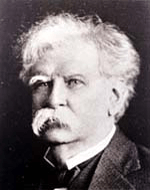Ethelbert Stewart
| Ethelbert Stewart | |
|---|---|
 | |
| Commissioner of the U.S. Bureau of Labor Statistics | |
|
In office April 1921 – June 1932 | |
| President | Woodrow Wilson, Warren G. Harding |
| Preceded by | Royal Meeker |
| Succeeded by | Isador Lubin |
| Personal details | |
| Born |
1857 Cook County, Illinois |
| Died | 1936 |
Ethelbert Stewart (1857–1936) was the commissioner of the U.S. Bureau of Labor Statistics (BLS) from 1921 to 1932.
Stewart worked as a coffin-maker, then founded and edited labor newspapers. He was made the commissioner of labor for the state of Illinois in the 1880s.[1] He was made deputy commissioner of the BLS in 1913 along with other roles in the U.S. Department of Labor.[2] In that position he had a public role in how the organization should track women workers, child labor, and occupational injuries and illnesses. In the fall of 1913 he mediated a coal mining dispute involving the Rockefeller interests in Colorado and helped resolve the Indianapolis streetcar strike of 1913. It was hard to keep the Bureau staffed during World War I and Stewart advocated offering pensions to civil servants.[3]
When commissioner Royal Meeker left in 1920, Stewart was nominated by President Woodrow Wilson to take the top role, newly elected President Warren Harding re-nominated him, and Stewart was confirmed in 1921. The Bureau began issuing productivity statistics in this period, and increased coverage of wholesale prices, employment and unemployment, and industrial safety statistcs.[3][2]
Publications and archives
- Ethelbert Stewart. "1913=100" , Monthly Labor Review 15:2 (Aug. 1922), pp. 11-12.
- Stewart's archives are kept at the University of North Carolina, Chapel Hill.[1]
References
- 1 2 Ethelbert Stewart Papers, 1884-1933 at Wilson Library at UNC-Chapel Hill
- 1 2 Commissioners: Ethelbert Stewart at bls.gov
- 1 2 Goldberg, Joseph P., and William T. Moye. 1985. First hundred years of the Bureau of Labor Statistics. Bureau of Labor Statistics Bulletin 2235. U.S. Government Printing Office. ISBN 0-935043-01-2. Chapters 4 and 5.